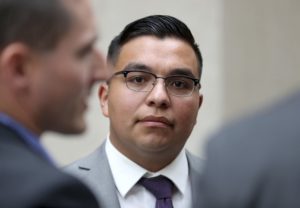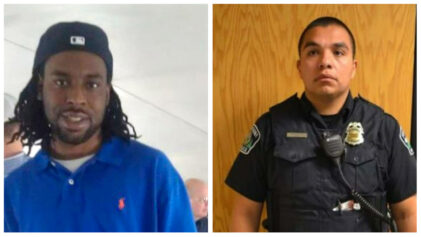
St. Anthony police officer Jeronimo Yanez charged with second-degree manslaughter in the death of Philando Castile last July 6. (David Joles/Star Tribune via AP)
ST. PAUL, Minn. (AP) — A Minnesota police officer charged in the death of a black motorist testified Friday that the man was pulling out his gun and ignoring his commands to stop when he shot him.
Officer Jeronimo Yanez, facing a manslaughter charge in the death of cafeteria worker Philando Castile, said he feared for his life and could clearly see the gun.
“I was scared to death. I thought I was going to die. My family’s faces popped up in my mind, my wife and baby girl,” Yanez said, his voice choked with emotion.
Prosecutors say Yanez’s actions were unreasonable. Castile, 32, had a permit for the weapon and prosecutors have sought to portray him as being cooperative when he volunteered to Yanez early during the stop on July 6, 2016, “Sir, I have to tell you, I do have a firearm on me.”
A central question at trial has been what Yanez saw before firing seven times, barely a minute after he approached the car. Squad car video recorded him telling a supervisor after the shooting that he did not know where the gun was, although it also recorded him saying he told Castile to take his hand off it.
Asked to explain the recording, Yanez said: “What I meant by that was I didn’t know where the gun was up until I saw it in his right thigh area.”
Prosecutors have argued that Yanez could have taken lesser steps when Castile told him he was carrying a handgun, such as asking to see Castile’s hands or asking where the gun was. After Castile told the officer he had the gun, Yanez told Castile, “OK, don’t reach for it then,” and, “Don’t pull it out.”
On the squad car video, Castile can be heard saying, “I’m not pulling it out,” as Yanez opened fire. Castile’s last words were, “I wasn’t reaching for it.”
Yanez said he felt he had no choice but to shoot. Castile “had total disregard for my commands,” he said.
“Did I want to shoot Mr. Castile at all? Those were not my intentions,” he said, taking off his glasses at one point and wiping his eyes with a handkerchief.
Earlier Friday, a use-of-force expert, Emanuel Kapelsohn, testified for the defense that Yanez was justified to shoot if he believed he saw a gun or that Castile was pulling one.
Prosecutor Jeff Paulsen, on cross-examination, asserted that “the ultimate question” in the case was whether Yanez saw a gun. Kapelsohn disagreed, saying the central question to him was whether Yanez “reasonably believed that Castile was pulling out a firearm.”
Paulsen also displayed autopsy photos that showed a graze wound to Castile’s trigger finger. Paulsen noted the absence of a bullet hole in Castile’s shorts or bullet damage to his gun — evidence, the prosecutor said, that showed he wasn’t reaching for the gun when shot.
Kapelsohn said it was possible Castile didn’t have his hand in or near his pocket at that point.
Defense attorneys argue that Castile was stoned at the time of the traffic stop and it influenced his response to the officer.


